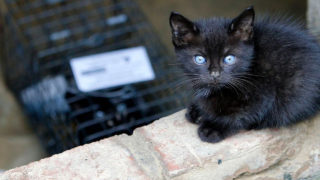Trap-Neuter-Return (TNR) ordinances sound like a good thing, and sometimes are a good thing. However, if not written carefully or overwritten, these ordinances can actually create barriers to the very humane programs they exist to support.
It’s tempting to think that your community MUST pass a TNR ordinance in order for advocates to really dig into a TNR program, but that is not true. If community cat caregivers are not struggling with opposition from animal control officers or hostility from neighbors, it is often preferable not to pursue an ordinance.
Well-intentioned ordinances can cause more harm than help if they create regulations and restrictions and, subsequently, penalties and liabilities against caregivers and TNR providers when no such obstacles were on the books before.
The most problematic TNR ordinance provision is mandatory registration. Mandatory registration means that community cat caregivers are legally obligated to register with animal control or another local government agency and include personal information about themselves and sometimes even the location of the cats they care for. For most people, this situation is far from ideal. A person who fails to register but continues to engage in TNR could be fined or even prosecuted for breaking the law.
These volunteers who open their hearts and wallets to care for cats are the core of an effective TNR program. It is critical for lawmakers to understand that community cat caregivers are NOT the owners of the cats. They do not create or increase community cat populations. Instead, they are good Samaritans providing a compassionate community service, and are the people most often on the front lines ensuring cats are spayed or neutered and vaccinated.
Registration is not necessary for successful TNR programs. It is burdensome and time-consuming and will cause citizens to cut back on their incredibly important work to spay and neuter community cats. Community cat caregivers are generally apprehensive about revealing who they are and where the cats are located. Unfortunately, their fears are well-founded. Alley Cat Allies has documented numerous instances of caregivers being subjected to verbal harassment, physical coercion, job loss, and eviction, and instances of the cats, once located, being trapped and killed.
If TNR ordinances are written correctly, however, or are needed to counteract existing harmful laws for cats, they can save lives. If your animal control ordinance is already being updated, or if your local animal shelter is embarking on a large, positive policy change, TNR ordinances are an excellent tool to codify protections for cats and their caretakers. Generally, brief ordinances that simply communicate the city’s support rather than dictate the “proper” steps of TNR and what caregivers must do are best.
For example, the Washington, D.C. ordinance underscores the city’s commitment to TNR and does not regulate the actual practice of TNR. It states that the animal control agency “shall promote: (1) the reduction of euthanasia of animals for which medical treatment or adoption is possible; and (2) the utilization of trap, spay or neuter, and return practices as a means of controlling the feral cat population.” This brief statement of the city’s policy and goals is very helpful in encouraging TNR.
You should also consider your animal shelter’s position on TNR programs. It has become much more common for shelters to participate in TNR. This program model, known as Shelter-Neuter-Return (SNR), has become more widespread because TNR results in a decrease in shelter intake. Ideally, ordinances should explicitly encourage or require, rather than simply permit, Shelter-Neuter-Return for impounded cats.
Sample Trap-Neuter-Return Ordinance Provisions
If your community is considering a TNR ordinance, the ordinance should include key definitions and provisions to best support cats and caregivers. These components include important protections for impounded community cats, such as mandating the return of cats to their colony, as well as protections for caregivers.
Remember, the primary goal is to implement TNR in your community. An ordinance is only one tool among many to achieve this objective.

